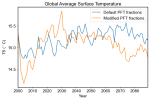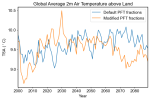Hi all,
I am doing some simulation experiments by changing PFT fractions to representing vegetation changes. I run simulations for 90 years with CESM2.1.2 ETEST(2000_CAM60_CLM50%SP_CICE_DOCN%SOM_MOSART_SGLC_SWAV_TEST) compset and with f19_g17 resolution.
./create_newcase --case ETEST_oldsurf --res f19_g17 --compset ETEST --run-unsupported
cd ETEST_oldsurf/
./xmlchange RUN_STARTDATE=2000-01-01
./xmlchange STOP_OPTION=nyears
./xmlchange STOP_N=90
./case.setup
./case.build
./case.submit
I have got monthly model output data for 90 years. However, I found the simulations cannot reach a steady or quasi-steady state according to diagnosis of temperature time series. The figure below shows the simulated global average surface radiative temperature (variable TS from CAM h0 output) and the average 2m air temperature over global land (variable TSA from CLM h0 output). The blue line is from control experiment with default PFT fractions and the orange line is from the experimental simulation with modified PFT fractions.


As the ETEST has not been scientifically supported, I don't know if the results are scientific. How should I tell if the simulated climate has reached equilibrium? Or how should I choose the years for model spin-up?
I would be grateful for any advice!
Xiaohe
I am doing some simulation experiments by changing PFT fractions to representing vegetation changes. I run simulations for 90 years with CESM2.1.2 ETEST(2000_CAM60_CLM50%SP_CICE_DOCN%SOM_MOSART_SGLC_SWAV_TEST) compset and with f19_g17 resolution.
./create_newcase --case ETEST_oldsurf --res f19_g17 --compset ETEST --run-unsupported
cd ETEST_oldsurf/
./xmlchange RUN_STARTDATE=2000-01-01
./xmlchange STOP_OPTION=nyears
./xmlchange STOP_N=90
./case.setup
./case.build
./case.submit
I have got monthly model output data for 90 years. However, I found the simulations cannot reach a steady or quasi-steady state according to diagnosis of temperature time series. The figure below shows the simulated global average surface radiative temperature (variable TS from CAM h0 output) and the average 2m air temperature over global land (variable TSA from CLM h0 output). The blue line is from control experiment with default PFT fractions and the orange line is from the experimental simulation with modified PFT fractions.


As the ETEST has not been scientifically supported, I don't know if the results are scientific. How should I tell if the simulated climate has reached equilibrium? Or how should I choose the years for model spin-up?
I would be grateful for any advice!
Xiaohe
